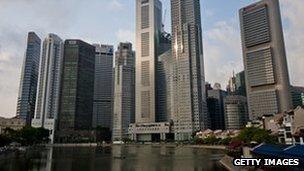Singapore projects 30% growth in population by 2030
- Published

A growing influx of foreigners is often blamed for rising property prices
Singapore's government has said it expects its population to grow 30% to 6.9 million by 2030.
In a keenly anticipated white paper, it said a key part of the growth will come from foreign workers and immigrants.
The government said immigration was needed to help offset a slowing birth rate and ageing population.
Criticism of Singapore's immigration policy has become more vocal recently, with many locals blaming it for a rise in property prices and living costs.
The government said that the issue was a complex one and that it needed to find a balance between the number of Singaporeans and foreigners in order to sustain its rate of economic growth.
"If we do too little to address the demographic challenge, we risk becoming a steadily greying society, losing vitality and verve, with our young people leaving for opportunities elsewhere," it said in the white paper, external.
"But if we take in too many immigrants and foreign workers, we will weaken our national identity and sense of belonging, and feel crowded out of our own home."
Shrinking population?
Singapore's total fertility rate, which represents the number of children that would be born to a woman if she were to live to the end of her child-bearing years, has been below the population replacement rate for more than three decades.
That has led to concerns that the number of Singaporeans may shrink in the coming years, and the government warned that it does not expect the situation to improve in the near future.
It said that "taking in younger immigrants will help us top up the smaller cohorts of younger Singaporeans, and balance the ageing of our citizen population".
It added that it will take in between 15,000 and 25,000 new citizens each year to "stop our citizen population from shrinking".
Meanwhile, it has also taken steps to encourage Singaporeans to have more babies.
Last week, it unveiled an incentives package worth 2bn Singaporean dollars ($1.6bn; £1bn) in an attempt to boost the birth rate.
This included support for conception, delivery and child-raising costs as well as paternity and shared paternal leave.
- Published23 January 2013
- Published22 January 2013
- Published14 January 2013